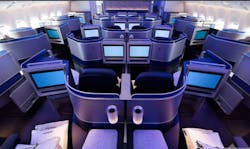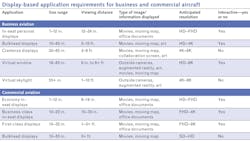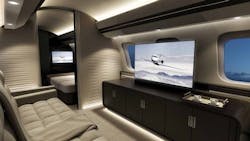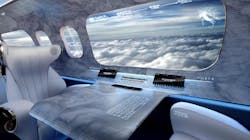Consumer aircraft cabins: the next display frontier
Every consumer knows that screens are everywhere now. And they are getting smarter, offering more connectivity and routinely responding to voice and touch commands. This trend is happening in homes, at shopping centers, in cars, and now in aircraft cabins. This upgrade cycle will happen in commercial aircraft, business jets, and even in new supersonic airplanes now being developed. This will include back-of-seat, bulkhead, and credenza displays, along with virtual windows and skylights.
Some of the concepts being planned are quite thrilling. The hardware and software opportunities for these long-lived installs could be very attractive for companies eager to participate in this next phase. But what are the trends driving this upgrade cycle and what are the requirements and needs for a range of new displays?
First, it is important to note that the needs of the aircraft markets are integrally tied to trends happening in other markets as well. Such trends will impact the desires of passengers, which in turn will drive requirements for displays and video-based solutions. The COVID-19 pandemic has considerably changed the way display screens are fundamentally used. While their use in education, video streaming, and home office work is likely to moderate a bit once the pandemic subsides, the advancements made in the delivery of these services, as well as the benefits offered to consumers and professionals, will remain. Consumers have come to rely heavily on an internet-connected world and the delivery of data and video-based services. It is not unreasonable to expect such requirements to also stretch into the aircraft market.
A similar need is already recognized in the automotive market. Vehicles are becoming smarter and more intuitive with an expanding array of displays for information, navigation, and entertainment. As autonomous capabilities roll out, passengers and even drivers will have more time to engage with various display-based solutions. And they will have high expectations for instant access to high-quality audio-visual entertainment and communication.
This trend is playing out in the home as well. Soon, one will be able to sit on their couch all day doing work or school, watching movies/TV, or playing games, as well as controlling their appliances, managing their environment, and monitoring and allowing access to their home.
In short, consumer expectations to access information and entertainment quickly and easily with high quality are a reality today, and these expectations are only going to increase in the future. Development of video/information solutions for aircraft takes years to develop and deploy, so it is essential that developers define requirements based on future market trends with the anticipation that these solutions will be in service for a decade or more.
Experience is the new watch
Until recently, consumers and passengers would watch entertainment and other content on their screens. But now, the expectations are changing, and consumers and passengers want to experience their content. How is an experience different?
There is no clear definition, but there are several factors that contribute to it. One factor that is rarely mentioned is audio. Multichannel audio in 5.1–7.1 channel configurations are now common and offer big upgrades over stereo audio (2.0). Even newer and more immersive solutions are available as well. Dolby Atmos and DTS-X formats add a height component to the audio to deliver sounds that are above the listener. Such audio can clearly create a more immersive environment.
Another clear trend toward immersion is screen size. Content creators don’t have a small screen in mind as their preferred format; they create movies for the cinema or large-screen TVs. Large screens greatly help to immerse the viewer with wider field-of-view. Average TV screen sizes have been increasing in recent years, with 65-in. being a common choice today.
Adding to the experiential impact is High Dynamic Range (HDR) content. HDR content expands the range of luminance values to reveal more details in dark shadows and deliver brighter highlights at the same time. When coupled with wider color gamut, not only are more colors displayed, but these colors can seem more vibrant because of their increased brightness.
A third factor is resolution. This continues to increase on almost all display applications, providing more detail and richness in textures. The 8K content displayed on 8K screens lack some of the visual artifacts that can be displayed with lower-resolution content and screens. As a result, images can sometimes take on a 3D-like appearance, such as like looking out a window. This is the kind of visual experience consumers and passengers can expect now and into the future.
These trends will drive expectations for aircraft cabin displays, from economy seats in commercial aircraft to business jets that will now include supersonic aircraft. It has been almost 20 years since the Concorde had the last commercial supersonic flight. But now, multiple companies are developing supersonic aircraft. This includes Boom, NASA, and Aerion/Boeing/Rosen Aviation. Advancements in aircraft design, engine technology, and consumer expectations are fueling this revival with aircraft that can significantly reduce the noise from the dreaded sonic boom while also creating greener operating conditions.
The table summarizes the anticipated display-based solutions that will be needed for the next decade in business and commercial aircraft.Credenza displays
The emergence of new display technologies is also enabling new applications in aircraft cabins that were not possible or feasible in the past. For example, thin and lightweight OLED displays can be made in rollable, flexible, and even semitransparent formats in addition to their normal rigid, opaque configuration.
The concept of a large screen (65+ in.) OLED display—potentially even a rollable version—on an aircraft can enable a credenza configuration that can be used for serving food and drinks and double as a cinema screen. Just roll up (or down) the OLED screen at 65 in. or larger to allow a small audience to feel like they are in their own private theater. Some luxury jets will clearly find this option attractive, as rollable displays are a very compact way to achieve a big screen experience (see Fig. 3).A large credenza display can also double as a collaboration screen where a work meeting can be held with several people, depending on size. And when not in use for that or a movie, it can display fine works of art. Here, we see the need for displays that will require up to 8K pixels depending upon the size.
Virtual windows
The ability to eliminate physical windows can save a lot of fuel by streamlining the aerodynamics of the aircraft. But this is only possible if virtual windows are available with high-enough quality to feel real. If not, many passengers may get a claustrophobic feeling.
The key piece of content on the virtual window will be what a passenger would expect to see if a real window were there. This will require an array of cameras on both sides of the plane with high-enough quality to not look like a soft video image. Over time, fewer cameras may be possible, as creation of high-quality views between the physical cameras will become more feasible (synthetic view generation). This would also enable “viewing through the wing,” a feature not possible with a real window (see Fig. 4). In addition to the “out the window” content, such displays could be used to overlay augmented-reality data such as altitude and speed, and even identify landmarks on the ground as you fly over them.Virtual skylights
The idea behind a virtual skylight is to replace the curved ceiling on an aircraft with a curved display surface. OLED displays can do this today. Such a display can be used to create a unique ambiance displaying colors, patterns, artistic images, or even the sky (real or simulated). Showing the sky can create a unique sense of openness in the cabin to help relieve any claustrophobic feelings and create a greater sense of space. These cutting-edge solutions can be configured to display an underwater environment, or stars and galaxies to give passengers the sensation of traveling through space.
Such display solutions could be crafted from a series of curved panels. The size and aspect ratio will vary by the space available in the ceiling, but a minimum of 4K resolution is suggested. These solutions are only likely in business or luxury aircraft (see Fig. 6).Interactivity
While some passengers will send content from their mobile device to the in-seat display, many will want to access content offered by the airline. Interaction with in-seat displays today is via a hand controller or a touchscreen added to the display. It is anticipated this requirement will continue in the future, so touchscreens need to be added to displays where passengers will be interacting with it.
Content connection options
Delivering the best image quality, no matter the source or application, should be the goal of developing a display solution. However, this solution goes beyond simply picking a high-quality display. Content image quality will vary widely, so image restoration technology is one critical element. How the content gets to the display matters just as much.
There are two scenarios to consider:
- Content comes from the passenger’s mobile device
- Content comes from the aircraft server
Many smartphones or tablets use the iOS or Android operating systems and there are multiple ways to get content from your mobile device to the screen in your living room or aircraft cabin. Wireless casting and mirroring are two popular techniques, for example.
Mirroring with an Apple device is called AirPlay, with AirPlay2 being the latest generation. Connection requires the AirPlay2 functionality be installed on a display or a streaming device. Android and Windows users can use a Chromecast dongle, while some models have Chromecast built into the display. AirPlay and Chromecast use Wi-Fi, so passengers will need to join the aircraft network and have AirPlay or Chromecast installed on the display. Miracast is an older screen-sharing approach that sets up its own Wi-Fi hot spot to allow connection to an HDMI port on the display (via a dongle for consumer applications). Laptop connection can likewise be completed via Chromecast or AirPlay. There are also company-specific solutions, so designers need to consider what opens to support including compatibility with iOS, Android, and Windows operating systems.
All of these solutions have an impact on the Wi-Fi network available in an aircraft, so care must be taken to ensure there is enough bandwidth to support intended passenger applications, from entertainment to work. For example, Wi-Fi 6 capabilities are likely to be commonplace in three years and is backwards-compatible with previous versions. A new 6 GHz band has recently been authorized in the U.S. as well, so this may also be a consideration for additional speed. Wi-Fi 6 should have enough bandwidth to support 8K applications, provided the overall network has adequate capacity.
In addition, passengers may want to connect their mobile device via a wired connection. If 8K video and 4K computer applications are to be supported, an uncompressed data rate of 30 Gbit/s is required (8K at 60 fps, 10 bits per color, and 4:2:0 color subsampling). The following connectors can support video playback:
- HDMI 2.1
- DisplayPort 1.4a with display stream compression applied
- DisplayPort 2.0 (over USB-C connector)
- ThunderBolt 4 (over USB-C connector)
While an HDMI 2.1 port is a good choice, so could be USB-C. This connector can support several different video transport protocols, including DisplayPort and ThunderBolt. It can also support charging and data transfer, but the designers need to be careful to choose solutions that can support these options as long as the passenger’s device can as well.
Finally, the aircraft needs to support direct delivery of movies, TV shows, maps, music, and more to each passenger’s seat as well as other displays in the cabin. Delivery of these services will be best performed over a wired network. Most likely, this would be an ethernet architecture. The bandwidth of this network needs to be sufficient to allow all passengers to access content or communicate in some way without a compromise in quality. This could mean 10 Gbit/s or 100 Gbit/s network solutions, which are readily available today and can support 8K distribution if needed.
Content delivery
Airlines can offer TV and movie content that is loaded onto the aircraft’s servers prior to the flight. They may also offer live TV content by accessing satellite broadcasts. Additionally, the aircraft will want to offer internet access to passengers via satellite connections.
Access to live content and the internet will increase in scope; designers need to keep this in mind when developing content ingest and network topologies. One example is Starlink, a system of thousands of low-Earth orbit mini satellites that will offer internet services with speeds that are supposed to reach up to 300 Mbit/s. Clearly, such high-speed options will be very attractive, and perhaps necessary, for business jet and first-class commercial passengers.
Whether content comes from a satellite or is preloaded on the aircraft server, quality will vary widely. That is why image processing and restoration technologies should be applied to all incoming content. Where and how this is done is an open question. Two options are possible:
1. Pass through content in the as-delivered format and allow the display to decode and provide any image restoration technology
2. Decode incoming content at the server, apply image restoration technologies, and re-encoding to deliver to the display
Option 1 puts more processing requirements at the display, potentially adding more costs, as this must be installed on all displays in the aircraft. It has the benefit of being able to improve content from the user’s mobile device, however.
Option 2 concentrates processing at the server, simplifying the display processing needs. But this can’t improve users’ mobile device content. This option has the benefit of being able to apply the latest encoding technologies to distribute content over the aircraft network. Encoding technologies are just now starting to take advantage of the capabilities artificial intelligence (AI) can offer to help speed up encode time, decrease compute complexity, and reduce bit rates. It would be smart for developers to upgrade the encoding software from time to time to take advantage of these rapid improvements that are expected in the coming years. Meanwhile, CPU and GPU power are fully capable of distributing 8K video today and storage costs continue to decline.
Both options are viable. It is more of a business decision.
Aircraft display solution developers need to design the system to become operational in 2–4 years and to last for a decade or more before a retrofit. That means they need to try to predict the needs of passengers as well as trends in media and entertainment, so that those capabilities are in the aircraft and function at high levels. Designers should prepare for an 8K transition by developing the required network and specifying larger-sized display solutions. Now is the time to begin planning for an 8K future.
About the Author
Chris Chinnock
Chris Chinnock is president and owner of Insight Media in Norwalk, CT. He is a 30-year display industry veteran with experiences in displays, broadcast, cinema, ProAV, and consumer electronics.




